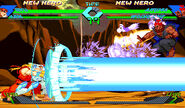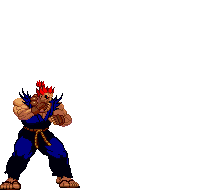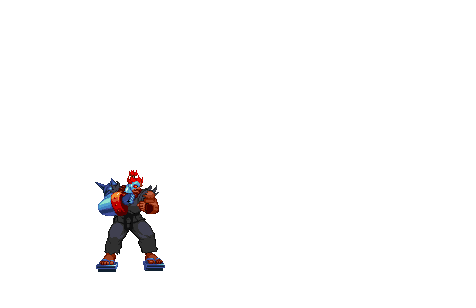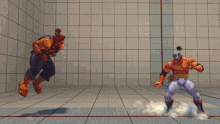
Tenma Gozanku in action
The Tenma Gou Zankuu (天魔豪斬空, "Heaven Demon Great Slashing Air") is one of Akuma's Super/Hyper Combos in his various appearances. It functions as a more powerful variant of his Zanku Hadoken.
In his appearance as Cyber-Akuma in Marvel vs. Capcom, the attack was called Thunder Gou Shower (サンダー 豪 シャワー, Sandaa Gou Shawaa).
| Street Fighter Alpha Street Fighter III Capcom vs. SNK |
|
|---|---|
| Marvel vs. Capcom Street Fighter V |
|
| Ultra Street Fighter IV (OMEGA Mode) | |
| Street Fighter 6 | (Classic) (Modern) |
Description[]
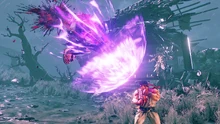
Tenma Gozanku in Street Fighter V.
In the Street Fighter Alpha, Street Fighter III and SNK vs. Capcom series, Akuma, while airborne, launches a single, large Zanku Hadoken; like the Messatsu Gou Hadou, this attack hits eight times if it connects.
In the Marvel vs. Capcom series, Akuma instead unleashes a barrage of Zanku Hadokens upon the opponent, inflicting a great deal of damage. It also notably slows down his descent to the ground for the duration, and he will not completely land when close to the ground until the move ends.
In Marvel vs. Capcom 3, the attack undergoes a notable change similar to his Messatsu Gou Hadou; the variants are called Tenma Gou Zankuu: Agyou (天魔豪斬空・阿形, "Heaven Demon Great Slashing Air: Open-Mouth Form") and Tenma Gou Zankuu: Ungyou (天魔豪斬空・吽形, "Heaven Demon Great Slashing Air: Closed-Mouth Form"). The former is a barrage of Hadoukens not unlike the original MvC series Tenma Gou Zankuu, while the latter done by holding down the Heavy button during the startup flash is a beam fired downward from both palms (like almost all Hadoken-based supers in the series). Unlike in past crossovers, only the Ungyou version can hit OTG.
The Tenma Gou Zankuu also makes an appearance in Ultra Street Fighter IV's OMEGA Mode for Akuma, appearing as one of the revamped EX Special versions of the Zanku Hadoken. It is executed the same way as the Zanku Hadoken, but uses all three punch buttons and requires a single section of the Super Combo Gauge. This variant has no pause for the animation, meaning that Akuma becomes vulnerable during the execution of this move. The attack is considerably faster than the heavy punch and EX Zanku Hadoken, hits thrice and travels almost as far as the heavy punch of the Zanku Hadoken. The attack can be used when jumping backwards, unlike the regular Zanku Hadoken. After launching the projectile, Akuma will descend in a straight line.
Tenma Gozanku would also reappear as Akuma's EX Zanku Hadoken in Street Fighter V, with many of the same attributes as its OMEGA counterpart. Its animation has Akuma form a small ball of energy in one hand while proceeding to add more with his other hand, launching the Tenma Gozanku. The initial pulse of energy has its own hitbox that combos into the actual projectile, letting it work as an instant air attack like a dive kick.
In Street Fighter 6 Tenma Gozanku returns as one of Akuma's Level 1 Super Art. He also regains the grounded version, Messatsu Gohado However, Akuma's animation is now akin to the Ungyou variant from Marvel vs. Capcom 3, rather than start from charging Zanku Hadoken ball to projectile shot. This move can only be performed during a neutral or forward jump. Tenma Gozanku is mainly used to finish juggle combos after launching the opponent into the air with Rago High Kick. If Akuma manages to hit the opponent with Tenma Gozanku at the peak of his jump, he may have enough frames to jump forward and perform a second Tenma Gozanku before they hit the ground.
Unlike the original Zanku Hadoken, the angle is often more consistently closer to 45° when fired, which is mostly true in the crossover titles and as of Street Fighter III.
Gallery[]
Sprites[]
Trivia[]
- In the PlayStation version of Marvel Super Heroes vs. Street Fighter, the move contains several shorter flashes compared to the game's arcade and Sega Saturn versions. As a result, the flashes are capable of causing epileptic seizures.
- This is one of the few techniques where Akuma calls out its name upon executing it, mainly via the "Gou Zankuu" part. In some games like Marvel vs. Capcom 3, he does yell out the whole name.
- The move appears to be inspired by the Sheng Long hoax, in which the description of the move closely matches as specified.
- The naming of his two different Gou Zankuu and Messatsu Gou Hadou forms likely references the naming of the pair of "niou" (deva kings) in Buddhist mythology.




